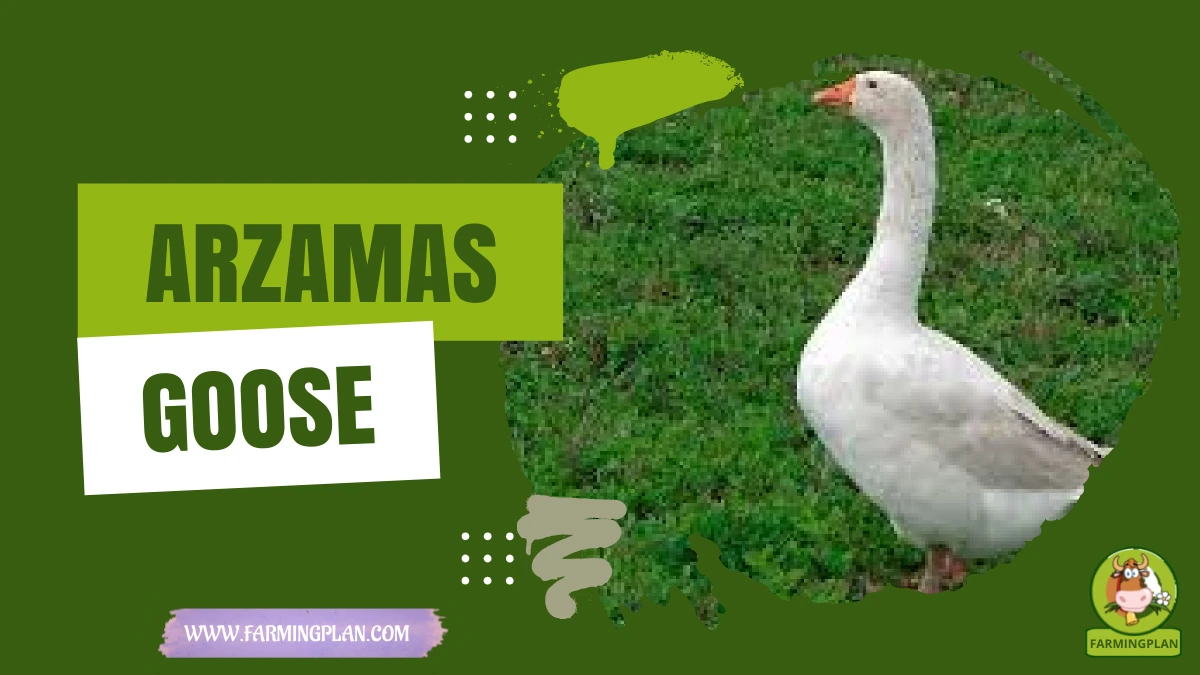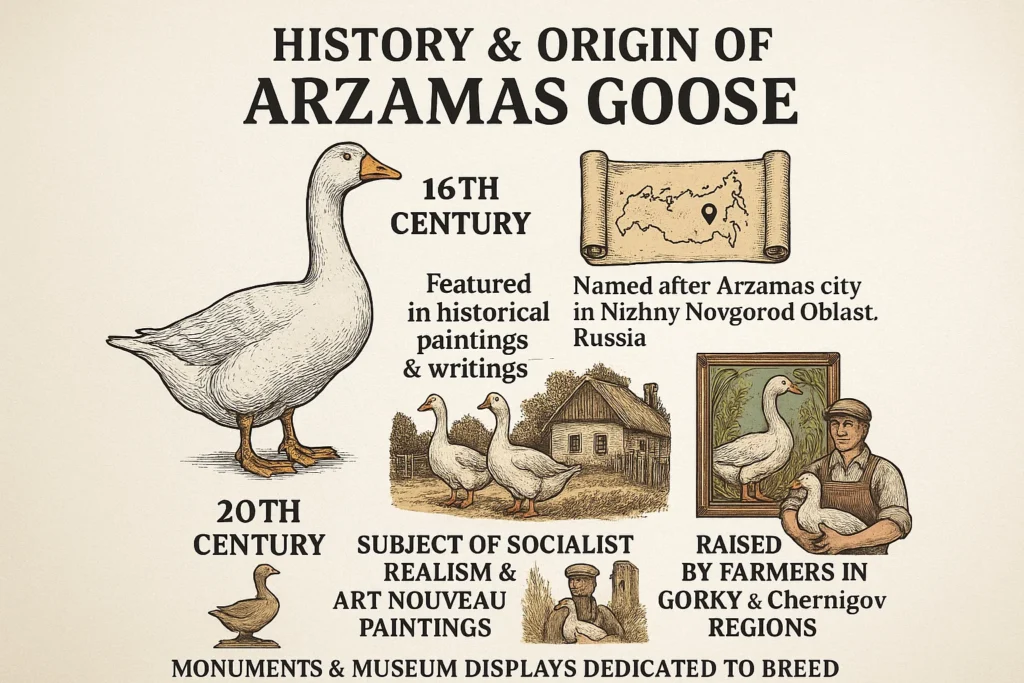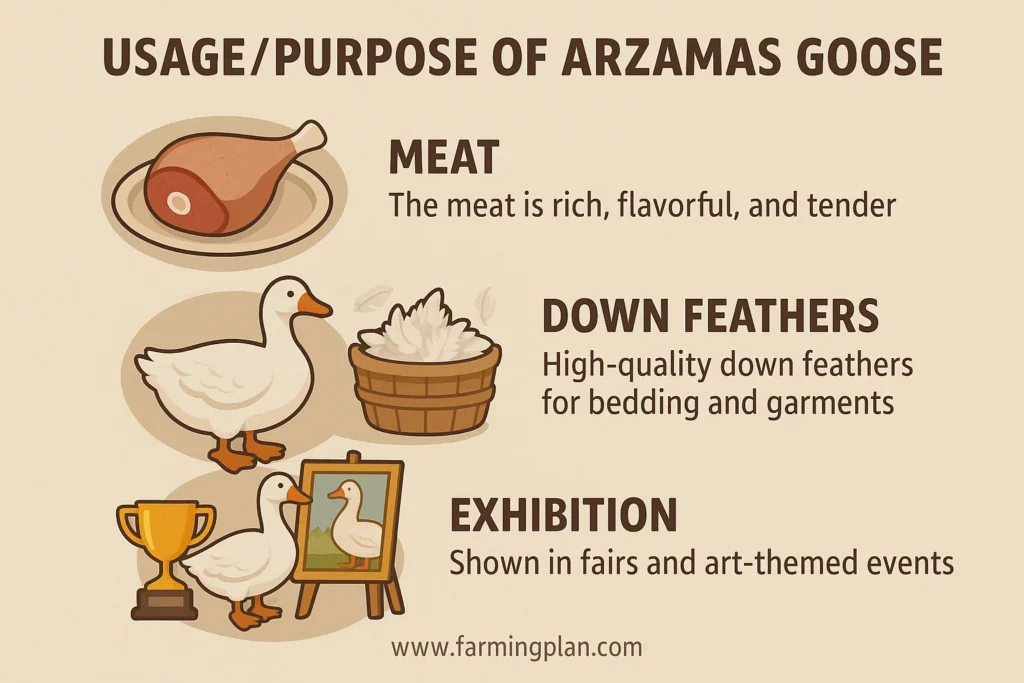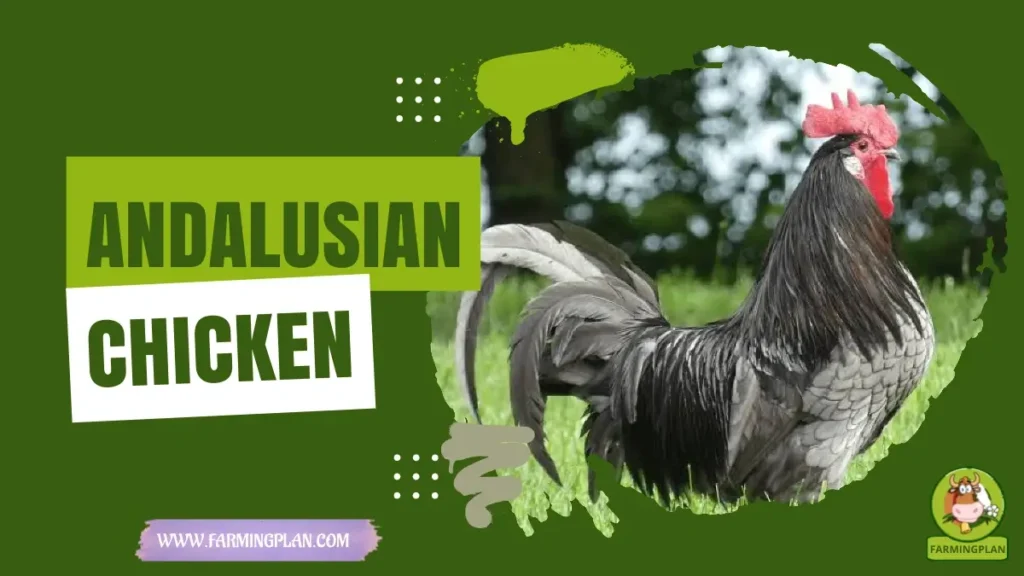The Arzamas Goose isn’t just a bird; it’s a cultural icon with deep roots in Russian tradition and art. With its snow-white feathers and proud stance, the Arzamas Goose has strutted through the pages of history and settled in the hearts of farmers and folklorists alike. Known for its strong meat quality and low maintenance needs, this breed thrives in tough conditions and adds a touch of old-world charm to any homestead. If you’re a hobbyist, breeder, or farmer like me, this guide will walk you through every step of understanding and raising Arzamas Geese—from their historical significance to feeding tips and expert care.

History & Origin of Arzamas Goose
The Arzamas Goose, a breed that dates back to the 16th century, takes its name from the Arzamas city in Nizhny Novgorod Oblast, Russia. These birds have long been associated with local folklore, art, and agriculture. Historical paintings and writings from the 18th and 19th centuries often featured these graceful geese in village settings, symbolizing fertility, prosperity, and home life.
This rich history connects us to a cultural heritage that is as enduring as the breed itself. By the 20th century, Arzamas Geese became a regional pride and a subject of Socialist Realism and Art Nouveau paintings. Farmers across the Gorky and Chernigov regions raised them not only for their hardy nature and meat quality but also for their symbolism.

You can even find monuments and museum displays dedicated to Arzamas Geese in the Arzamas Museum of History, especially around Karl Marx Street. The All-Union Poultry Breeding Research Institute officially recognized this breed’s resilience and cultural value, and selective breeding began refining its traits further.
Read More: Euskal Oiloa Chicken: Ultimate Friendly Heritage Breed
Characteristics of Arzamas Goose
Arzamas Geese are medium-heavy birds with compact bodies, snow-white plumage, and short necks that give them a dignified appearance. Adult males weigh around 6–7 kg (13–15 lbs), while females weigh slightly less at 5–6 kg (11–13 lbs). Their calm eyes and sturdy build add to their rustic charm. Unlike Chinese or Italian geese, Arzamas Geese mature faster and adapt better to harsh climates.
Their short legs and broad chests make them appear stout but elegant. One fascinating trait is their loud, clear honking, which they use to communicate within flocks. Their feather quality is also impressive, and they are often used in traditional Russian crafts. They reach sexual maturity relatively early, and their breeding performance remains stable even in extensive conditions.
Nature/Temperament of Arzamas Goose
These geese are calm, loyal, and a bit territorial, making them great natural guards for your flock. Unlike more aggressive breeds, Arzamas Geese surprisingly tolerate children and small animals. In my experience, they form tight family bonds, often pairing for life and caring deeply for their young.
They may not be as social as ducks, but they’re affectionate in their own stoic way. They tend to thrive in open spaces, so if you have a pasture or backyard pond, you’ll see their best personalities come to life. Just don’t crowd them too much—they value their personal space.
Food & Diet of Arzamas Goose
Feeding Arzamas Geese is pretty straightforward. I start them on gosling starter feed and switch to grain-based compound feed by week 5. Adult birds do well on a mix of grains, greens, and occasional protein boosts like boiled eggs or mealworms. They love free-ranging and will eat grass, weeds, and small insects.
Supplement with calcium during the egg-laying period to prevent shell issues. Don’t forget clean water—geese love to dip their food and clean their bills. Avoid feeding them processed foods, salty items, or spoiled feed. Monitor daily intake to keep feed consumption in check. This helps reduce waste and keeps the birds in top shape.
Usage/Purpose of Arzamas Goose
Arzamas Geese are primarily raised for their rich, flavorful meat. The meat is tender and lean, making it a delicacy in Russian cuisine. They are also known for high-quality down feathers used in traditional bedding and garments.

Some farmers raise them for exhibition, especially in regions with a strong cultural appreciation like Arzamas, Pskov, and Gorky. These geese often appear in fairs and art-themed events, proudly representing centuries-old Russian heritage. Their calm temperament and aesthetic appeal also make them a preferred choice for hobby farmers looking to add character to their flocks.
Read More: Pigeon Breeds That’ll Win Your Heart Instantly
Special Features of Arzamas Goose
One unique feature of the Arzamas Goose is its ability to adapt to a wide range of climates, from freezing Russian winters to temperate summers. Their meat quality improves with age—without getting tough.
Their early maturity and efficient feed conversion mean you spend less to get more. They also have a strong immune system, reducing the need for frequent vet visits. You’ll also find them to be fantastic grazers, lowering your feed bill if you provide enough pasture. Their cultural significance and visual elegance are just the cherry on top.
Health Issues & Prevention of Arzamas Goose
Arzamas Geese are hardy, but you still need to watch for common poultry diseases. Keep an eye out for symptoms like lethargy, nasal discharge, or abnormal droppings. These could signal respiratory issues or parasites. Regular deworming, clean housing, and fresh water go a long way in preventing illness.
I use apple cider vinegar in water occasionally to boost gut health. Always isolate sick birds and consult a vet if symptoms persist. Regular checks, especially during the egg-laying season, can prevent long-term issues. Don’t skip vaccinations recommended by your local poultry authority.
“Feed Them Well, Treat Them Right, And Arzamas Geese Will Give You Their Best Day And Night!”
Step-by-Step Farming Guide of Arzamas Goose
Step 1: Preparing The Habitat
Start with a secure, draft-free coop that allows at least 3–4 square feet per goose. Ensure good ventilation and dry bedding using straw or wood shavings. Add a shallow pond or tub for bathing—they love water.
Step 2: Feeding Routine
Feed goslings a starter feed with 18–20% protein—transition to grower feed at 6 weeks. By 12 weeks, they can switch to adult grain-based feed. Supplement with greens and allow pasture access daily.
Step 3: Breeding & Egg Care of Arzamas Goose
Arzamas Geese start breeding by 8–10 months. Provide nesting boxes lined with soft bedding. Collect eggs daily and store in a cool place. Hatch using incubators or let the goose brood naturally.
Step 4: Daily Maintenance
Every morning, clean their water troughs and check feed levels. Let them graze and swim for exercise. Remove old bedding weekly to prevent disease. Check feet and feathers for signs of injury or mites.
Step 5: Monitoring Health & Growth of Arzamas Goose
Weigh your geese monthly. Look for signs of abnormal behavior or poor appetite. Keep a basic first-aid kit with electrolytes, probiotics, and dewormers. Keep in touch with a local poultry vet.
Expert Tips & Best Practices of Arzamas Goose
- Start with a small flock to learn their behavior.
- Use rubber mats in wet areas to avoid foot injuries.
- During winter, use deep litter method to keep them warm.
- Never overcrowd the coop—space matters more than you think.
- Mix grit into feed weekly to help digestion.
- Add natural herbs like oregano or garlic powder in feed to boost immunity.
“If You Want Happy Geese, Let Them Roam Free And Swim Every Day.”
FAQs
Are Arzamas Geese good for beginners?
Yes, their calm nature and low-maintenance care make them ideal for first-time goose keepers.
How long do Arzamas Geese live?
With proper care, they live up to 15–18 years.
Do Arzamas Geese fly?
They are not strong fliers and usually prefer walking or swimming.
How many eggs do they lay per year?
They typically lay around 20–30 eggs during the laying season.
Can they live with other animals?
Yes, they coexist well with chickens and ducks, especially when raised together.
Conclusion
Raising Arzamas Geese isn’t just about meat or feathers—it’s about preserving a living symbol of culture and tradition. These birds offer reliable returns, beautiful aesthetics, and a connection to a deeper historical narrative. With proper care, feeding, and a bit of love, they’ll reward you with loyalty, quality meat, and a whole lot of charm. Whether you’re a backyard hobbyist or a small-scale farmer, adding Arzamas Geese to your life is a step toward reviving heritage and embracing nature. So, are you ready to let these proud white birds waddle into your world? Let’s keep this tradition alive—one goose at a time!

